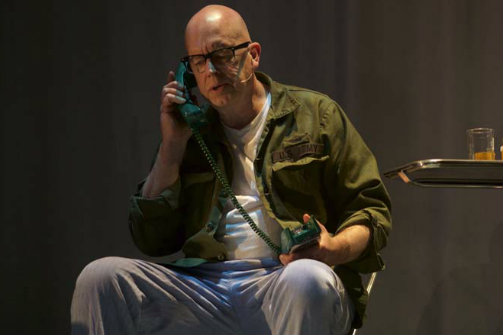
My Lai
By Jonathan Berger and Harriet Scott Chessman; Directed by Mark DeChiazza and Rinde Eckert
Part of BAM's 2017 Next Wave Festival
Off Broadway, Opera
Runs through 9.30.17
BAM Harvey Theater, 651 Fulton Street, Brooklyn
by Regina Robbins on 9.29.17
 Rinde Eckert in My Lai. Photo by Zoran Orlic.
Rinde Eckert in My Lai. Photo by Zoran Orlic.
BOTTOM LINE: A new, small-scale opera tells the story of one of the darkest days of the Vietnam War, and doesn’t shy away from its complexities.
For Americans of a certain age, the name "My Lai" is instantly recognizable; for those too young to remember the war in Vietnam, no doubt the 18-hour documentary currently running on PBS will include testimony pertaining to the horrific events of March 16, 1968, in which U.S. soldiers killed hundreds of defenseless civilians. For both of these groups, there is the boundary-breaking opera playing this weekend at BAM; called simply My Lai, it is a beautiful, sorrowful work.
Based on the account of Warrant Officer Hugh Thompson, an American helicopter pilot who was on a reconnaissance mission when he saw the massacre from above, My Lai is a non-linear, fragmented piece, directed by Mark DeChiazza and multi-hyphenate artist Rinde Eckert. Eckert also plays Thompson: now an older man at the end of his life (he passed away in 2006), the pilot is still haunted by the events of that day, singing (in a tenor you have to hear to believe), "I am caught in this...I will always be in it, shouting at the captain. I’m still shouting." Thompson’s emotions veer from anger to confusion and regret; though he managed to interrupt the killing and save some lives, he has never achieved closure, partly due to the fact that in the aftermath, the military attempted to brand him a traitor. The libretto, written by Harriet Scott Chessman, reflects Thompson’s uneasy psyche: sometimes poetic, sometimes disjointed.
Composer Jonathan Berger has created a dissonant score with nary a hummable melody anywhere; Thompson’s intervention in the massacre may have been heroic, but the dominant theme of this piece isn’t heroism, but horror. This dark and beautiful music is performed by the Kronos Quartet, musicians who have collaborated with everyone from Philip Glass (naturally) to Elvis Costello, and Vân-Ánh Võ, who plays a number of traditional Vietnamese instruments. With Eastern sounds to one side of him and Western ones on the other, Eckert stands alone in the middle, the opera’s sole vocalist (though the performance does include recorded voices and other sounds). The set is a simple hospital room—IV stand, metal chairs, side table—upon whose white privacy curtains images from the present and the past appear: the shadows of doctors, the windblown grass of a rice paddy, a billowing wall of fire.
My Lai is only about 75 minutes long, far shorter than what one generally expects of an opera; its creators could easily have taken a more straightforward approach, with multiple acts and a large cast, taking us from Vietnam to Washington, D.C. to the Louisiana hospital where Thompson ultimately died. Perhaps one day, someone will tell that version of this story. For now, we have this small but profound memory piece that insists that we confront the agony of war while simultaneously reminding us that evil can never fully be understood.
(My Lai plays at the BAM Harvey Theater, 651 Fulton Street, Brooklyn, through September 30, 2017. The running time is one hour and fifteen minutes with no intermission. Performances are Thursday through Saturday at 7:30. Tickets are $28-$55 and are available at bam.org.)
My Lai is by Jonathan Berger (music) and Harriet Scott Chessman (libretto), in collaboration with David Harrington and Vân-Ánh Võ. Directed by Mark DeChiazza and Rinde Eckert. Set Design is by Mark DeChiazza and Rinde Eckert. Video Projection Design is by Mark DeChiazza. Lighting Design is by Brian H. Scott.
The cast is Rinde Eckert (vocalist). The musicians are David Harrington (violin), John Sherba (violin), Hank Dutt (viola), Sunny Yang (cello), and Vân-Ánh Võ (t’rung, dàn bâu, dàn tranh).

